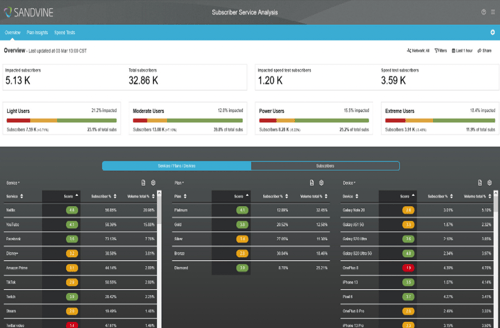When apps don’t deliver the experience people want, you need a powerful combination of network and subscriber analytics to make quick, accurate decisions
“Good enough” is no longer truly enough when it comes to the delivery of apps. Delivering the “best app QoE” is critical now that apps are coursing through virtually all human engagements:
- Person-to-person interactions (via social networking, messaging, video conferencing, gaming)
- Productivity (communications and collaboration, CRM management, project management, expense management)
- Entertainment (video streaming, gaming, web)
- Life enhancement and improvement (M2M, IoT, wearables)
- Learning (educational apps, web)
With apps becoming so integral to life, it’s a big deal when they don’t work the way they’re supposed to. If your networks or systems are even perceived to be the primary cause of a bad app experience – even if they’re actually not the root cause – your brand will take a hit of some sort.
Margins are thin and churn increasingly common, so “hunt-and-peck” troubleshooting practices and high-stakes guessing games have to give way to more intelligent, automated processes and tools. Non-repeatable and non-scalable practices take a toll on not only customers, but also IT staff and O&M costs. That’s especially true when compounded over thousands of users.
You need solutions that solve targeted problems, but without overwhelming IT staff with too many options and too much complexity. The goal is to solve, or better yet, prevent application performance problems by adjusting network configuration, resources, and policies to the ever-changing conditions of today’s more complex applications.
Becoming more responsive to real-time conditions will help you assure QoS and evolve toward QoE-centric services and revenue streams, such as those for 5G network slicing and other 5G business use cases.
Look Beyond Network Metrics to ‘QoE Scoring’
Basic network metrics (like KPIs for speed tests and throughput) help uncover link congestion or node failures, but fail to consider the conditions that actually impact application performance. They are limited in scope and don’t put app QoE data in troubleshooting workflows.
In today’s more complex apps, it’s necessary to understand the customer experience across different application categories (video, gaming, live TV, social, conferencing, messaging, web, VoIP, file sharing , etc.), as well as across individual applications. It's important to see how applications respond to changing network conditions and what impact that might have on customers. For example, cloud gaming applications might be far more sensitive to latency, whereas video streaming apps might require higher throughput to deliver a good experience to users.
It's also necessary to understand who your subscribers and subscriber groups are across the spectrum of usage, from light or average, to heavy or excessive, and what that means in terms of how their experience is matching their expectations.
Additionally, you must understand what devices your subscribers are using for different categories of apps and service plans.
As stated earlier, these types of insights are often buried under larger network quality issues.
To reveal app QoE issues, we leverage QoE scoring capabilities across three analytics use cases that directly pertain to app QoE: Performance Monitoring and Analysis, Subscriber Service Analysis, and Real-Time Subscriber Insights.

The scoring is based on key application network requirements, such as throughput, latency, and packet loss. These requirements combine with KPIs and metrics for network, last mile, and devices, and bring contextual data to QoE scores.
Sophisticated scoring reveals anomalies, such as viral content, attacks in progress, or the start of live events – so you can adjust your network configuration, resources and policies accordingly.
Through tightly integrated dashboards, scoring's key metrics and KPIs come to life, with both short-term and long-term views that help you:
- Identify worst performing network locations, overutilized locations, and isolate persistent, chronic problematic sites
- Generate baseline scores for comparison when changing or upgrading the network
- Compare post-upgrade and pre-upgrade network performance based on location, application/service, etc. following maintenance work to improve operational efficiency
- Improve ROI by prioritizing capacity and quality upgrades
Furthermore, customized drilldowns into cross-sections of applications and the subscriber base can help you visualize how your top apps are performing and even help in your NOC-to-SOC transitions.
These capabilities are complemented by our new Subscriber Service Analysis Solution, which draws correlations and troubleshoots subscriber-specific problems. It answers key QoE-specific questions, like “was the experience poor because low-end plans aren’t supporting minimum video streaming requirements," or, "are certain devices performing OS updates across the networks at certain times that are more likely to compromise video quality?"
The data that is important to these questions are delivered via the Application and Network Intelligence Portal, which uses advanced machine-learning traffic classification to dig into traffic – even if encrypted – to accurately classifying unique applications within different categories.
These capabilities work in conjunction with Sandvine’s Insights family of analytics solutions, making it possible to aggregate and visualize subscriber-specific data through real-time and historical views designed to illuminate customers’ network experiences, helping to isolate quality issues, usage overages, and billing disputes.
Additionally, integration with operational and business support systems provides a full understanding of the customer interaction with the network. This use case also draws on the ANI Portal, enabling care teams to reduce the volume, length, and escalation levels of customer care calls.
These solutions are designed to reduce mean-time-to-resolution and first call resolution rates, leading to greater customer satisfaction and reduced customer retention and management costs.
To find out more about how our use cases can deliver better app QoE for you, schedule a demo and register for our upcoming webinar “Managing Heavy Usage: Deliver the Best App QoE to the Most Customers.”
Additionally, download the Global Internet Phenomena Report, in which you can see the types of reports you can tailor to your own needs.
Other related resources to check out include:
Performance Monitoring and Analysis,
Subscriber Service Analysis
Real-Time Subscriber Insights
Gaming QoE Analysis
Heavy User Management
Use Case eBook
Video QoE Analysis
Video Streaming Management
Intent-based Congestion Management
Topics: Featured, Customer Experience, App QoE, Root Cause Analysis, Troubleshooting, Subscriber Analytics





